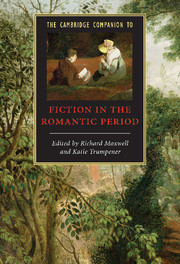Book contents
- Frontmatter
- Introduction
- 1 The historiography of fiction in the Romantic period
- 2 Publishing, authorship, and reading
- 3 Gothic fiction
- 4 The historical novel
- 5 Thinking locally: novelistic worlds in provincial fiction
- 6 Poetry and the novel
- 7 Orientalism and empire
- 8 Intellectual history and political theory
- 9 Women writers and the woman’s novel: the trope of maternal transmission
- 10 Tales for child readers
- 11 Sentimental fiction
- 12 Fiction and the working classes
- 13 The Irish novel 1800-1829
- 14 Scotland and the novel
- Further reading
- Index
- Series List
1 - The historiography of fiction in the Romantic period
Published online by Cambridge University Press: 28 January 2009
- Frontmatter
- Introduction
- 1 The historiography of fiction in the Romantic period
- 2 Publishing, authorship, and reading
- 3 Gothic fiction
- 4 The historical novel
- 5 Thinking locally: novelistic worlds in provincial fiction
- 6 Poetry and the novel
- 7 Orientalism and empire
- 8 Intellectual history and political theory
- 9 Women writers and the woman’s novel: the trope of maternal transmission
- 10 Tales for child readers
- 11 Sentimental fiction
- 12 Fiction and the working classes
- 13 The Irish novel 1800-1829
- 14 Scotland and the novel
- Further reading
- Index
- Series List
Summary
There is widespread agreement that the Romantic period exists as a meaningful span of time - even if it is defined less by Romanticism per se than by a strong revolutionary trend. By contrast, the fiction written in the Romantic period has only occasionally been treated as an integral subject. It is true that Walter Scott never disappeared from view (even when most people stopped reading him), that Jane Austen had strong admirers from the beginning - including Scott - and that the creature of Mary Shelley's Frankenstein became a general byword and remains one, even or especially for people who don't know the book Frankenstein itself. A few other writers, such as Maria Edgeworth and Thomas Love Peacock, managed to keep readers and reputations. However, that doesn't make quite enough books to constitute a larger entity called “fiction of the Romantic period.” For an era rich both in brilliant experimentation and achieved masterpieces, this one has tended to drop off the map, despite various attempts during the last two centuries to demarcate it.
Such recovery efforts and their often equivocal success will be the focus of this chapter, which looks at four moments - windows of opportunity - when for one reason or another the idea of a body of fiction produced during the Romantic period and conceivable as an overall topic of inquiry and opportunity for reading came into focus. One such moment is early (1785); one, around 1830, provides a sort of instant retrospect; one occurs just after World War I, marking a decisive turn in modern literary studies; one is the present - which is to say, the last few decades, culminating in the publication of Peter Garside, James Raven, and Rainer Schöwerling's The English Novel: 1770-1829.
- Type
- Chapter
- Information
- Publisher: Cambridge University PressPrint publication year: 2008
- 1
- Cited by



